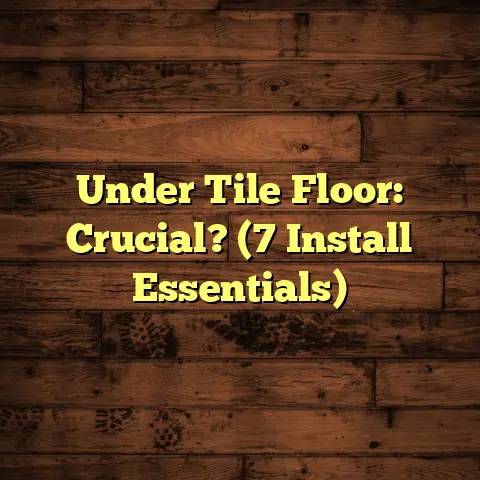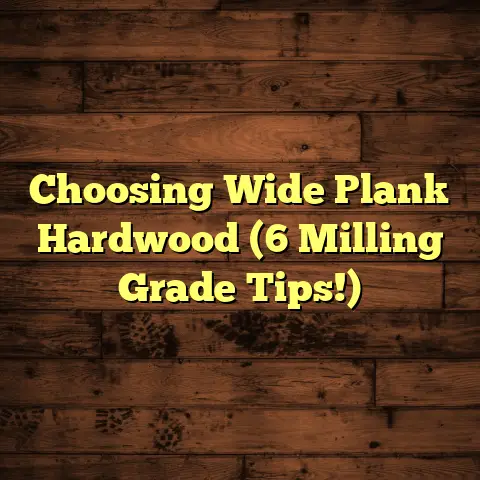Carpet vs Laminate Cost? (Save $500 NOW!)
I get it. I’ve been a flooring contractor for over 15 years, and I’ve seen firsthand the confusion and stress homeowners face when choosing between carpet and laminate.
Let me tell you about the Smiths. They were a young family, eager to renovate their living room. They envisioned a cozy, inviting space, but they were torn.
Carpet’s plush comfort beckoned, but laminate’s sleek, modern vibe also appealed. The budget was tight, and every dollar mattered.
The pressure was on to make the right choice.
This decision wasn’t just about aesthetics; it was about their hard-earned money and the long-term comfort of their home.
So, how do you navigate this flooring maze?
Let’s break down the real costs of carpet vs. laminate, and I’ll even show you how you can potentially save $500 right now!
1. Overview of Carpet Flooring
1.1 Definition and Types of Carpet
Carpet. It’s more than just a soft covering for your floor. It’s a textile floor covering made from fibers, typically synthetic like nylon or polyester, or natural like wool.
The type of fiber, the way it’s constructed, and the density all affect its durability, feel, and price.
Think of it like this: a cheap, thin carpet is like a basic t-shirt, while a high-end, plush carpet is like a luxurious cashmere sweater.
Here’s a quick rundown of common carpet types:
-
Plush: Soft, smooth, and luxurious. Great for bedrooms, but can show footprints easily.
-
Berber: Loop pile construction, known for its durability and stain resistance. Ideal for high-traffic areas.
-
Frieze: Twisted fibers that create a textured, casual look. Hides dirt well and is very durable.
-
Saxony: Cut pile with a dense, refined look. Formal and elegant, but can be prone to wear.
-
Cut & Loop: Combines cut and looped fibers for a patterned effect. Offers both style and durability.
The choice really depends on your lifestyle and the room’s purpose. A family room with kids and pets needs something different than a formal dining room, right?
1.2 Cost Breakdown of Carpet Installation
Alright, let’s talk money. How much does carpet really cost?
It’s not just the price per square foot you see on the tag. There’s more to it than that.
Here’s a breakdown:
-
Carpet Material: This is the big one. Prices range from \$2 to \$10+ per square foot, depending on the fiber, style, and brand.
- Example: A basic polyester carpet might be \$2-\$4/sq ft, while a high-end wool carpet could be \$8-\$12+/sq ft.
-
Underlayment/Padding: This goes under the carpet and provides cushioning, insulation, and extends the carpet’s lifespan. Expect to pay \$0.50 to \$2 per square foot.
- Pro-Tip: Don’t skimp on the padding! It makes a HUGE difference in comfort and longevity.
-
Labor: Installation costs vary depending on your location and the complexity of the job. I typically see \$1 to \$3 per square foot for professional installation.
- DIY Alert: You can install carpet yourself, but it’s tricky. Uneven seams and improper stretching can lead to problems down the road.
-
Removal & Disposal of Old Carpet: Don’t forget about this! Removing and disposing of your old flooring can cost \$0.50 to \$1 per square foot.
-
Additional Costs: Tack strips, seam tape, and furniture moving can add to the final bill. Budget an extra \$100-\$300 for these incidentals.
Let’s do some math:
For a 200 sq ft room, a mid-range carpet (say, \$5/sq ft) with padding (\$1/sq ft) and professional installation (\$2/sq ft) would cost:
(200 sq ft x \$5) + (200 sq ft x \$1) + (200 sq ft x \$2) + \$150 (removal/disposal) + \$100 (incidentals) = \$1950
Ouch, right? It adds up fast.
1.3 Pros and Cons of Carpet
Okay, so you know the costs. But what are the actual benefits and drawbacks of carpet?
Pros:
-
Comfort: This is the big one! Carpet is soft, warm, and cozy underfoot. Perfect for bedrooms and living rooms.
-
Insulation: Carpet provides excellent insulation, helping to keep your home warmer in the winter and cooler in the summer. This can lead to energy savings.
-
Noise Reduction: Carpet absorbs sound, reducing echo and noise levels. Great for apartments or homes with kids.
-
Safety: Carpet provides a softer landing surface, reducing the risk of injury from falls.
-
Variety: Carpets come in countless colors, patterns, and styles, allowing you to create a truly personalized look.
Cons:
-
Maintenance: Carpet requires regular vacuuming and occasional professional cleaning to remove dirt, stains, and allergens.
-
Staining: Carpet is susceptible to stains from spills, pets, and everyday wear and tear.
-
Lifespan: Carpet typically lasts 5-15 years, depending on the quality and traffic.
-
Allergens: Carpet can trap dust, pollen, and other allergens, which can be a problem for people with allergies.
-
Moisture: Carpet can be damaged by moisture and can promote mold growth in damp environments.
So, is carpet right for you? Think about your lifestyle, your budget, and your tolerance for maintenance.
2. Overview of Laminate Flooring
2.1 Definition and Types of Laminate
Laminate flooring is a synthetic flooring option designed to mimic the look of hardwood, tile, or stone.
It’s made of multiple layers, including a high-density fiberboard (HDF) core, a decorative photographic layer, and a durable wear layer.
The wear layer is key! It protects the floor from scratches, dents, and fading.
Think of it as a tough shield for your floor.
Here are some common laminate styles:
-
Wood-Look: This is the most popular style, mimicking various wood species like oak, maple, and hickory.
-
Tile-Look: Replicates the appearance of ceramic or porcelain tile, often with grout lines.
-
Stone-Look: Mimics natural stone like slate or travertine.
-
Distressed: Features a weathered, aged look with knots and imperfections.
-
Handscraped: Offers a textured surface that resembles hand-scraped hardwood.
Laminate is a chameleon. It can adapt to almost any design aesthetic.
2.2 Cost Breakdown of Laminate Installation
Let’s crunch some numbers again. How much does laminate really set you back?
Here’s the breakdown:
-
Laminate Material: Prices range from \$1 to \$5+ per square foot, depending on the thickness, quality, and style.
- Example: A basic laminate might be \$1.50-\$2.50/sq ft, while a thicker, higher-quality laminate could be \$3-\$5+/sq ft.
-
Underlayment: This goes under the laminate to provide cushioning, sound insulation, and moisture protection. Expect to pay \$0.30 to \$1 per square foot.
- Important: Some laminate flooring comes with pre-attached underlayment, which can save you time and money.
-
Labor: Professional installation typically costs \$1 to \$4 per square foot, depending on the complexity of the job.
- DIY Friendliness: Laminate is generally easier to install than carpet, thanks to its click-lock system.
-
Removal & Disposal of Old Flooring: Just like with carpet, you’ll need to factor in the cost of removing your old flooring. Expect to pay \$0.50 to \$1 per square foot.
-
Additional Costs: Transition strips, baseboards, and quarter-round molding can add to the final bill. Budget an extra \$50-\$200 for these items.
Let’s do another calculation:
For a 200 sq ft room, a mid-range laminate (say, \$3/sq ft) with underlayment (\$0.50/sq ft) and professional installation (\$2/sq ft) would cost:
(200 sq ft x \$3) + (200 sq ft x \$0.50) + (200 sq ft x \$2) + \$150 (removal/disposal) + \$100 (incidentals) = \$1450
Notice anything? It’s generally cheaper than carpet!
2.3 Pros and Cons of Laminate
Time to weigh the benefits and drawbacks of laminate:
Pros:
-
Durability: Laminate is highly resistant to scratches, dents, and fading, making it ideal for high-traffic areas and homes with pets.
-
Ease of Cleaning: Laminate is easy to clean with a damp mop or cloth. No special cleaners required!
-
Affordability: Laminate is generally less expensive than hardwood or tile.
-
Installation: Laminate is relatively easy to install, especially with click-lock systems.
-
Variety: Laminate comes in a wide range of styles and colors to suit any decor.
Cons:
-
Less Warmth: Laminate can feel colder underfoot than carpet or hardwood.
-
Noise: Laminate can be noisy to walk on, especially without a good underlayment.
-
Limited Refinishing Options: Laminate cannot be refinished like hardwood. If it’s damaged, you’ll need to replace it.
-
Moisture Sensitivity: While some laminate is water-resistant, it’s not waterproof. Excessive moisture can cause swelling and damage.
-
Resale Value: Laminate may not add as much value to your home as hardwood.
So, is laminate the right choice for you? Consider your budget, your lifestyle, and your tolerance for noise.
3. Comparative Cost Analysis
Alright, let’s get down to brass tacks. Which is cheaper: carpet or laminate?
3.1 Initial Costs
Here’s a side-by-side comparison of initial costs per square foot:
| Cost Category | Carpet (Low-End) | Carpet (Mid-Range) | Carpet (High-End) | Laminate (Low-End) | Laminate (Mid-Range) | Laminate (High-End) |
|---|---|---|---|---|---|---|
| Material | \$2 – \$4 | \$5 – \$7 | \$8 – \$12+ | \$1 – \$2 | \$3 – \$4 | \$5+ |
| Underlayment/Padding | \$0.50 – \$1 | \$1 – \$1.50 | \$1.50 – \$2 | \$0.30 – \$0.50 | \$0.50 – \$0.75 | \$0.75 – \$1 |
| Labor | \$1 – \$2 | \$2 – \$3 | \$3 – \$4 | \$1 – \$2 | \$2 – \$3 | \$3 – \$4 |
| Total (per sq ft) | \$3.50 – \$7 | \$8 – \$11.50 | \$12.50 – \$18+ | \$2.30 – \$4.50 | \$5.50 – \$7.75 | \$8.75+ |
As you can see, laminate generally has a lower initial cost, especially at the lower end of the spectrum.
3.2 Long-Term Costs
But what about the long run? It’s not just about the upfront price, right?
-
Maintenance: Carpet requires more frequent cleaning and stain removal, which can add to the cost over time. Laminate is easier to clean and maintain.
-
Replacement Frequency: Carpet typically needs to be replaced every 5-15 years, while laminate can last 10-20 years or more.
-
Home Value: Hardwood flooring (which laminate often mimics) can increase home value more than carpet.
-
Repair Costs: Carpet repairs (stain removal, patching) can be more frequent than laminate repairs (replacing a damaged plank).
In the long run, laminate can be more cost-effective due to its durability and lower maintenance requirements.
3.3 Hidden Costs
Beware of the hidden costs! These can sneak up on you and blow your budget.
-
Subfloor Preparation: Uneven or damaged subfloors need to be repaired before installing either carpet or laminate. This can add significant costs.
-
Moisture Mitigation: If you have moisture issues in your basement or crawl space, you may need to install a moisture barrier before installing flooring.
-
Furniture Moving: Moving heavy furniture can be costly, especially if you hire professionals.
-
Unexpected Repairs: You might uncover hidden problems during the flooring removal process (e.g., asbestos, mold).
-
DIY Mistakes: If you attempt a DIY installation and make mistakes, you could end up paying more to fix them.
Always factor in these potential hidden costs when budgeting for your flooring project.
4. Real-Life Case Studies
Let’s get real. Here are a couple of case studies based on my experience:
4.1 Case Study of Carpet Installation
The Johnsons:
- Project: Replacing carpet in a 250 sq ft bedroom.
- Carpet Choice: Mid-range nylon plush carpet at \$6/sq ft.
- Padding: Standard padding at \$1/sq ft.
- Installation: Professional installation at \$2.50/sq ft.
- Removal & Disposal: \$150
- Additional Costs: \$100 (tack strips, seam tape)
- Total Cost: (250 x \$6) + (250 x \$1) + (250 x \$2.50) + \$150 + \$100 = \$2525
- Experience: The Johnsons loved the soft, cozy feel of the new carpet. However, they were concerned about potential stains from their kids and pets.
- Satisfaction Level: 8/10. Happy with the comfort, but worried about maintenance.
4.2 Case Study of Laminate Installation
The Millers:
- Project: Installing laminate flooring in a 300 sq ft living room.
- Laminate Choice: Mid-range wood-look laminate at \$3.50/sq ft.
- Underlayment: Standard underlayment at \$0.50/sq ft.
- Installation: DIY installation (saved on labor costs).
- Removal & Disposal: \$175
- Additional Costs: \$75 (transition strips, baseboards)
- Total Cost: (300 x \$3.50) + (300 x \$0.50) + \$175 + \$75 = \$1550
- Experience: The Millers were pleased with the durability and easy maintenance of the laminate. They found the DIY installation relatively straightforward.
- Satisfaction Level: 9/10. Happy with the cost savings and durability.
These are just two examples, but they illustrate the potential cost differences and experiences associated with carpet and laminate.
5. Conclusion
So, what’s the verdict?
Carpet offers comfort and warmth, but it comes with higher maintenance and potential staining issues. Laminate provides durability and affordability, but it can lack the cozy feel of carpet.
Remember the Smiths from the beginning? After carefully considering their budget and lifestyle, they opted for a high-quality laminate in their living room.
They saved money upfront and felt confident about the floor’s durability.
The potential savings of $500 (or more!) are definitely achievable if you make informed choices and shop around.
Budgeting and planning are crucial in flooring decisions. Don’t rush the process. Get quotes from multiple contractors, compare prices, and read reviews.
Ultimately, the best flooring choice depends on your individual needs and preferences.
Call to Action
Now it’s your turn!
Evaluate your own flooring needs, consider the information I’ve shared, and make a cost-effective and satisfying flooring choice for your home.
Don’t be afraid to ask questions, do your research, and trust your gut.
Your floors are the foundation of your home. Choose wisely!





